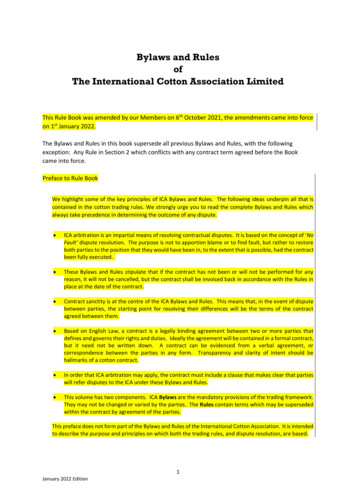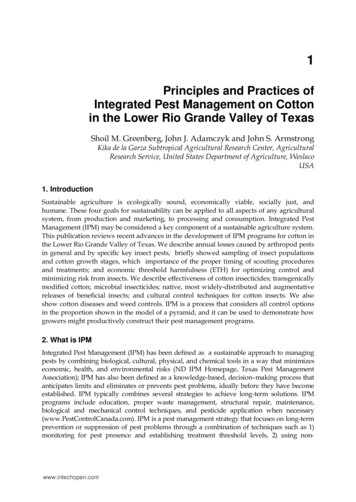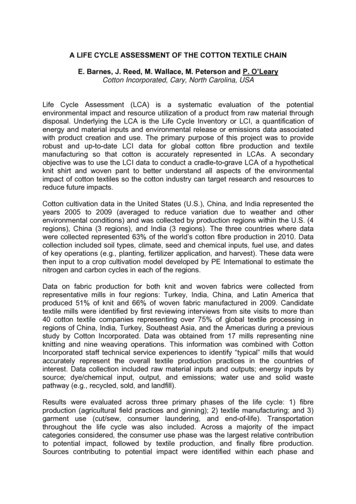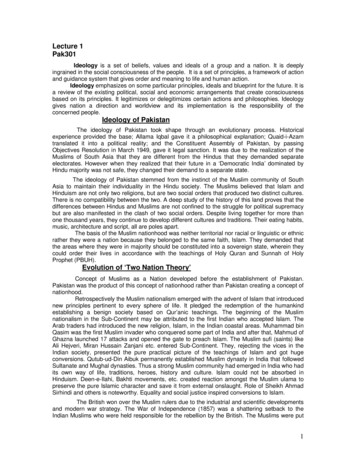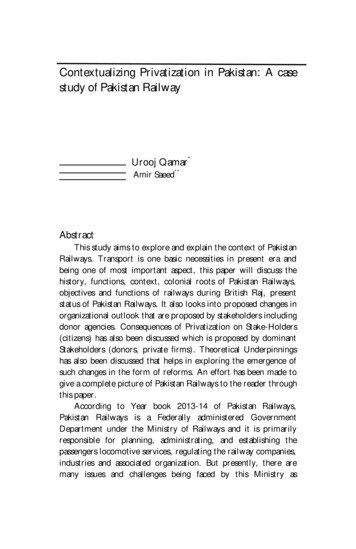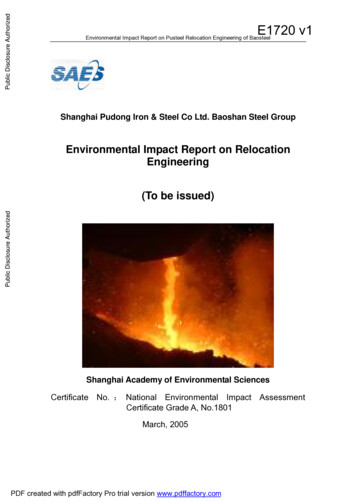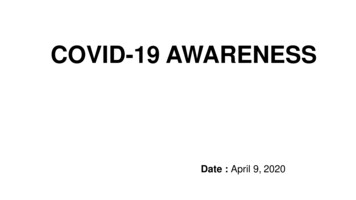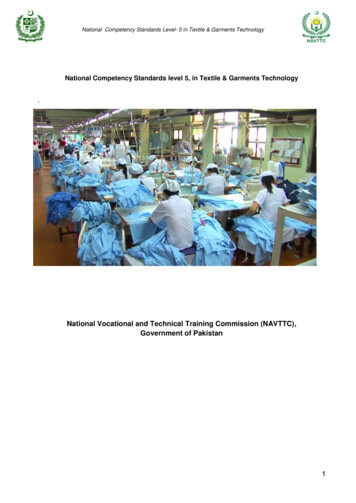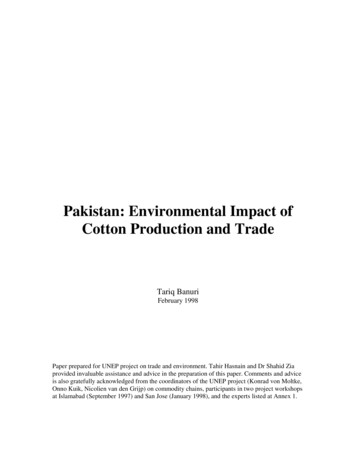
Transcription
Pakistan: Environmental Impact ofCotton Production and TradeTariq BanuriFebruary 1998Paper prepared for UNEP project on trade and environment. Tahir Hasnain and Dr Shahid Ziaprovided invaluable assistance and advice in the preparation of this paper. Comments and adviceis also gratefully acknowledged from the coordinators of the UNEP project (Konrad von Moltke,Onno Kuik, Nicolien van den Grijp) on commodity chains, participants in two project workshopsat Islamabad (September 1997) and San Jose (January 1998), and the experts listed at Annex 1.
IISD is producing this paper as part of its capacity building program for developing countries on the issuesof trade and sustainable development – the Trade Knowledge Network Project. This work was carried outwith the aid of a grant from the International Development Research Centre, Ottawa, Canada.The Knowledge Networks Project aims to build capacity in developing countries to address the issues oftrade and sustainable development. It consists of three main areas of work: domestic-level research andworkshops on the linkages between trade and sustainable development at the local and internationallevels; additional research on cross-cutting themes of interest to developing country policy-makers; andthe linking of developing country research institutions in a trade and sustainable development knowledgenetwork.For more information on the Trade Knowledge Network Project, see http://iisd.ca/tkn/, or contact IISD atinfo@iisd.ca.IISD contributes to sustainable development by advancing policy recommendations on international tradeand investment, economic instruments, climate change, measurement and indicators, and natural resourcemanagement. Using Internet communications, we report on international negotiations and broker knowledgegained through collaborative projects with global partners, resulting in more rigorous research, capacitybuilding in developing countries and better dialogue between North and South.IISD’s vision is better living for all -- sustainably; its mission is to champion innovation, enabling societiesto live sustainably. IISD receives financial support from the governments of Canada and Manitoba,governments of other countries, UN agencies, foundations and the private sector. IISD is registered as acharitable organization in Canada and has 501 (c) (3) status in the U.S.Copyright 1999 International Institute for Sustainable DevelopmentPublished by the International Institute for Sustainable DevelopmentAll rights reservedPrinted in CanadaCopies are available from IISD.This publication is printed on recycled paper.International Institute for Sustainable Development161 Portage Avenue East, 6th FloorWinnipeg, ManitobaCanadaR3B 0Y4Tel: (204) 958-7700Fax: (204) 958-7710E-mail: info@iisd.caInternet: http://iisd.ca
TABLE OF CONTENTSI. Background . 11. Introduction . 12. The global cotton commodity chain. 33. Trends in the cotton industry. 64. The role of cotton in Pakistan . 95. The commodity chain in Pakistan . 10II. Cotton Production. 156. Trends and descriptions. 167. Pesticide use in cotton production. 178. Environmental effects of pesticide use. 209. Alternatives to conventional cotton. 239.1 Genetically engineered cotton . 239.2 Integrated Pest Management . 239.3 Organic agriculture. 259.4 By way of a summary. 2710. System of governance. 27III. Textiles. 3511. Introduction . 3512. Environmental problems . 3913. Treatment options. 4314. System of governance in the textile industry . 4515. Prospects of a transition . 46ANNEX 1: Data sources . 48ANNEX 2: The SDPI Questionnaires. 51ANNEX 3: Cotton: Socio-Economic Profile . 53BIBLIOGRAPHY . 55
LIST OF CHARTS1. Pakistan: Comparison of international and domestic prices of cotton lint2. Pakistan: Exports of cotton and cotton products3. Pakistan: Area under cotton4. Pakistan: Cotton production and yields5. Pakistan: Cotton share prices relative to general prices912171740LIST OF TABLESTable 1: Exports of Cotton and Cotton Products, 1995-96 (Rs billion). 12Table 2: Calculations of area used for export of cotton products . 13Table 3: Estimated share of domestic use and exports of cotton products. 14Table 4: Average cotton output and yields, 1946-50 and 1991-95 . 17Table 5: Price increase in cotton . 39Table 6: Textile industry pollution levels and environmental standards. 42LIST OF BOXESBox 1: THE COTTON CHAIN IN PAKISTAN. 57Box 2: Production Costs Per Hectare (1996-97). 58
I. Background1. IntroductionThe purpose of this paper is to explore prospects and mechanisms for a transitionto sustainable development in Pakistan (and more generally in the South), and the effectof international trade on such prospects. The context of the study is a globalizing world inwhich trade is expanding rapidly, production is increasingly for a global market, theautonomy of the state is shrinking at a time when its obligations are increasing, and therecontinue to be significant differences in the capacity of different producers to respond toincentives, opportunities, and constraints.The specific case examined here is cotton and cotton products, which togetherconstitute the largest and most important economic sector in Pakistan, with considerabletrade exposure at every stage of production. It is a global activity involving economic andpolitical interests around the globe; it has long been the subject of North-South tradenegotiations, and is a prominent feature of negotiations over trade and the environment.Recent years have seen growing concern in industrialized countries about theenvironmental impact of cotton production and processing. The bona fides of suchconcerns have come under question from various southern governments and academics,given that their emergence coincided with the efforts (specifically the negotiation of theGATT Agreement on Textiles and Clothing) to dismantle the single most significant tradebarrier imposed explicitly by the North against the South. Some writers have argued, andmany governments believe, that the environment is simply another means by which theNorth will try to restrict southern imports and thus protect its uncompetitive textileproducts. (CUTS 1997)Be that as it may, it is a fact that conventional production methods (of cotton aswell as textiles) are associated with significant and avoidable environmental or healthrelated costs--even if it is conceded, as claimed by Southern critics, that these costs are ofa lower order of magnitude than of many Northern products or of synthetic alternatives.1Environmental costs derive from the use of agro-chemicals (especially pesticides) andwater at the primary stage, and that of industrial chemicals at the secondary stage,especially in dyeing, processing and finishing of cloth. Earlier, the motivation for theconcerns was the health of farmers and workers, quality of soil and water, and local1Southerncritics do not question the negative environmental impact of cotton production, especially forproducing countries. They question rather the selective focus on southern industries, and lesser criticism ofequally or higher polluting northern practices (eg energy intensive transportation systems). Others point outthat cotton is more environmentally benign than its synthetic alternatives. For example, in a study preparedby the sports clothing firm, Patagonia Inc. (1991, cited in WWF/IISD 1997: 76), cotton had the lowestrating of environmental risk severity (3.45), followed by wool (4.36), and nylon and polyester (4.73 each).In citing this study, IISD/WWF warn of a possible conflict of interest given that Patagonia is a clothingmanufacturer. However, probably a higher proportion of its revenues derives from clothing made fromsynthetic products.1
biological diversity. The signing of the GATT agreement added other concerns, inparticular the affect on consumers of carcinogenic dyes and chemicals (especially azodyes), and production processes resulting from inadequate environmental safeguards andstandards that create a competitive disadvantage for ‘cleaner’ industries in the North.These concerns have led to a number of actions to induce a switch to suchsustainable alternatives as organic cotton, integrated pest management, chemical-freetextile processing,2 and effluent quality standards. Actions include purely domestic ones,namely pesticide regulation, price intervention, and research and extension on integratedpest management (IPM). Internationally initiated actions involve the creation of tradebarriers by the private sector and consumers (eg through eco-labelling), orgovernmentally imposed import restrictions on grounds of product or process measures.There is also (admittedly limited) technical assistance to selected producers by northerngovernments as well as businesses.These initiatives are hampered by analytical blinders. Some approaches aretechnology-driven and assume that the only obstacle to sustainable production is the lackof knowledge of technological alternatives. Even others assume homogenous producers,equally capable of entering niche markets, altering their technological and managerialsystems, and managing brand names. Far from being neutral, all of these favor thestrongest segments of the chain, namely modern producers, operating at a relatively largescale, with preferential access to credit, technology, and governmental resources.The reality is substantially different, albeit quite varied. In Pakistan, the cottonsector exhibits considerable diversity in terms of virtually every characteristic: unit size,formality of industrial structure, nature of competition, and underlying cultural andgovernance systems. At one extreme are 1.3 million cotton farms (of which roughly halfare smaller than 2 hectares) competing in almost classic perfect competition, a vastmajority operated as family farms by owners/ cultivators with limited literacy or access totechnology. The main determinant of technological change in this sector is thegovernmental system of research and extension--which has become quite ineffective overtime. At the other extreme are large scale textile processors and small scale garmentmanufacturers, both subject to the influence of large international corporations, andindeed a part of an internationally governed commodity chain. In the middle are largescale spinning units and small-scale, informal sector weaving units, the latter numberingin the tens of thousands, mostly operating as family enterprises, with virtually norecognized system of industrial governance.The responsiveness of these groups to market driven as well as regulatory changesis likely to be highly varied. Without an understanding of the underlying system ofgovernance, it is impossible to identify fruitful forms of intervention. To further suchunderstanding, we use the framework of global commodity chains, especially the conceptof industrial governance, as articulated by Gary Gereffi (1994) and his colleagues.2For example, growing naturally coloured cotton, or using natural instead of synthetic dyes or bleaches.2
The data for the study was collected from a number of official statisticalpublications, as well as a questionnaire survey and direct interviews with leading expertsand practitioners around the country. Details on the published sources, experts, and thetwo questionnaires, one for cotton and the other for textiles are given in Annex 1. Concretely, the paper makes the following arguments:The responsiveness of individual actors in a production chain to changing incentivestructures is linked closely to the nature of governance in the chain. In the absence ofan effective system of governance (as in cotton production, ginning, and spinning),transition costs are likely to be high as well as inequitably distributed.Given the nature of the commodity chain at the upper end of the market, the costs oftransition will fall disproportionately on the manufacturers, while the benefits ofchanging consumer preferences will accrue to mass retailers who have a comparativeadvantage in labeling, packaging, advertising, and certification and inspection.The switch would be impossible without ready access to clean productiontechnologies. Alternative technologies exist in some areas (eg processing), and are inan experimental stage in other areas (eg green cotton). In the remaining areas (egIPM), while the meta-technology has been well developed, its contextual applicationand dissemination is not anywhere near the range of feasible options.A feasible program must seek to intervene in existing governance systems, and eitherstrengthen them in order to facilitate the transition, or to transform them throughinvestment and technical assistance to produce an orderly and equitable transition tosustainability.2. The global cotton commodity chainThe cotton commodity chain can be divided into three broad stages: production,processing, and marketing. While conditions in the stages exhibit certain similarities,there are significant differences as well. In particular, while the governance structure ofapparel manufacture is controlled by mass retail firms, and that of cotton growing bygovernmental institutions, albeit increasingly ineffectively, yarn and cloth productiondoes not exhibit a coherent governance arrangement. Yarn production is in the large scaleorganized sector, where the manufacturers association can operate as a lobby to influencegovernment policies. The weaving sector, however, is fairly anarchic in its composition.These differences are critical in evaluating the effectiveness of intervention in productionsystems.The textiles and apparel industry is a classic example of what Gary Gereffi (1994)terms a buyer-driven global commodity chain, in other words one that is driven by largeretailers rather than producers or processors. According to Gereffi, commodity chainshave three main dimensions: 1) and input-output structure, 2) territoriality, ie spatialdispersion or concentration of enterprises of different sizes and types, and 3) agovernance structure, ie the authority and power relationships that determine howfinancial, material, and human resources are allocated and flow within a chain. The3
purpose is to examine the nature of the relationships between various economic agents inorder to understand the sources of stability and change.The difference between producer driven and buyer driven commodity chains isprimarily in terms of their governance structures. Producer driven chains are defined asthose in which ‘transnational corporations or other large industrial enterprises play thecentral role in coordinating the production system. This is most characteristic of capitaland technology-intensive industries like automobiles, computers, aircraft, and electricalmachinery . Buyer driven chains refer to those industries in which large retailers, brandname merchandisers, and trading companies play the pivotal role in setting updecentralized production networks in a variety of exporting countries, typically located inthe Third World’ (Gereffi 1994: 97). The main job of the core company in buyer drivenchains is to manage production and trade networks. Profits derive not from scaleeconomies and technological advances as in producer driven chains, but rather fromunique combinations of high value research, design, sales, marketing, and financialservices.This distinction, and in particular the concept of governance, is helpful inexamining the commodity chain and exploring the prospects for transformation ofproduction processes. Governance can be described in a number of ways. A gooddefinition is to think of it as an arrangement in which collective decisions can be made ina legitimate manner and with the minimum of conflict. As Gereffi has reminded us, in amarket context, governance is derived from market power. Market power meaning theability to control or influence markets, is mainly the result of industrial structure.Enterprises in oligopolistic or monopolistic have the ability, and as a result excess profits.In other words, it is linked closely with economies of scale, barriers to entry, and natureof industrial concentration.Market power is self-reinforcing; in the sense that it provides actors with theability to maintain their preferential position by actions that help create and sustain afavorable market environment. Typically, this has meant the control of ones competitorsthrough collusion or price fixing (eg, the threat of predatory pricing), the control of thepolicy environment by ‘managing’ governmental actors, and the control of consumerchoices through advertising and brand name development. All these actions create a biasin favor of large scale and established enterprises, even when the technology itself is scaleneutral.The concept of governance provides an additional dimension to such strategicaction. This means managing ones suppliers or other intermediaries in such a way as toenhance total sector profits.3 Such management requires strategies for the distribution of3Gereffi (1994: 99) notes the relationship of his analysis with the concept ‘flexible specialisation’ (seePiore and Sabel 1984). Another related concept is that of ‘collective efficiency’ introduced by HubertSchmitz and his colleagues at the University of Sussex. They see the informal sector organised in a manneras to enhance the collective efficiency and profitability of a community of producers. This is very similar toGereffi’s analysis, even though it suggests a decentralised form of governance. See Schmitz (1988).4
benefits as well as threat of costs. Naturally, this requires the investment of financial andhuman resources in the management of economic relations with trade partners. It alsomeans the creation of the ability to introduce changes in behavior, either by the promiseof rewards or the threat of sanctions. Rewards and sanctions refer mainly to access tocredit, markets, technology, and know how. Given the relationship of scale andprofitability with the generation of such surplus resources, it is not surprising thatproducer driven chains are characterized by strongly oligopolistic production structures,whereas buyer driven chains are dominated by monopolistic or oligopolistic retail firmsand brand name companies.However, the idea of market-based governance is relatively new, and is in a sensethe ‘privatization’ of activities that were traditionally the sole domain of government.Even now, wherever market power or an attitude towards governance is not in evidence,the only provider of governance remains the government. As such, to add to Gereffi’scategories, one could equally think of a ‘government-driven’ commodity chain. In thistype of a chain, the flow of financial, material and human resources through a chain isinfluenced strongly by the policies and actions of government agencies. The agriculturalsystem in Pakistan exhibits this kind of structure. The combination of agriculturalresearch, extension, policy, credit, and input provision is used to influence the allocationdecisions of farmers. As we shall observe in more detail below, this system hasdeteriorated over time, and is unable to perform its responsibilities effectively. It has alsobecome somewhat captive to the actions of input suppliers.Finally, one could also think of an ‘anarchistic’ or ‘governance-less’ commoditychain, where there is an absence of governing arrangements between producers.Typically, the informal sector in many southern countries exhibits such behavior. InPakistan, the production of cloth is almost entirely in the informal sector.An issue that must be raised here to address the special conditions in the farmsector, although it is perhaps not central to the segments examined by Gereffi, is that ofthe system of knowledge underlying production arrangements. Stephen Marglin (1990) inhis analysis of the organization of work among informal sector weavers’ communities inEastern India distinguishes between two approaches to knowledge. He terms these‘episteme’ and ‘techne’. The former refers to knowledge that is cerebral, axiomatic, anduniversal, transmittable in transparent and internally egalitarian ways. The latter is tacit orembodied knowledge, contextual and personal, typically transmitted through experienceand prolonged exposure, often through hierarchic arrangements. The two embodycontrasting processes of innovation, diffusion, and legitimacy. Episteme derives itslegitimacy from impersonal research practices, and techne from personal trust.4It is fair to say that in the cotton commodity chain, the knowledge base insegments that correspond most closely to perfect competition correspond most closely to4Marglin is careful to say that these two ideal types are present in all forms of knowledge production.However, the modern world view views episteme as the only legitimate form of knowledge, and techne atbest as practice waiting to be transformed into true knowledge.5
Marglin’s techne, while that of the large scale and modern segments is epistemic. Theresult is that intervention in perfectly competitive segments requires an alternativesensibility, an approach to knowledge as personal and based on trust, constantly seekinglegitimacy.To revert to the main theme of this paper, the following analysis will use theconcept of industrial governance to motivate the discussion. This concept suggests thatthe prospects of transformation of industrial methods depend fundamentally on the natureof governance in that sector. In this sense, we could divide the cotton commodity chaininto three broad segments: Apparel and textiles are characterized by buyer driven commodity chains,and strong governance arrangements. Here there the prospects for industrialtransformation are relatively bright. However, the main issue here is that ofequity, support for equitable distribution of costs and benefits from thetransformation, and indigenous processes of transformation. Intervention insmall-scale production will require personal and face to face interaction. Theexisting program of sustainable industrial development offers prospects oflinking up with international processes to determine more equitable andefficient outcomes. Yarn and gray cloth are characterized by relatively weak forms ofgovernance, albeit with significant differences between them. Yarn productionis in the large-scale sector, where the manufacturers association acts as alobbying group, while weaving is in the informal sector without a coherentcollective structure. The prospects of transformation are more muted here, andprecipitate actions will involve considerable social and economic inequities aswell as avoidable costs. The agenda here is the institution of governancearrangements. However, the environmental costs of these stages of productionare smaller than those of the others, and this could be viewed as a longer-termprogram. Cotton growing is still characterized by government driven initiatives builtupon a vast complex of research, extension, input supply, and credit. Thesearrangements have become weak and non-optimal over time. Here the agendais the restoration of the system of governance by investing in the research andextension network. Alternative networks will have to deal with the obstacle ofdeveloping trust and language to communicate with farmers.3. Trends in the cotton industry5Cotton is the largest revenue earning non-food crop produced in the world. Itsproduction and processing provide some or all of the cash income of over 250 millionpeople worldwide, including almost 7 per cent of the available labor force in developingcountries. These activities are becoming highly concentrated over time; today, 77 per centof global cotton output and 73 per cent of the cotton hectarage are accounted for by5Fora good description of cotton production, see IISD/WWF (1997).6
China, the US, India, Pakistan, and the Central Asian Republics. Other features of thesector are: Cotton cultivation covers nearly 33 million hectares, equivalent to about 2.5 per centof all cultivable land, in 82 countries. Southern countries produce 77 per cent of theworld’s cotton, and constitute 58 per cent of world cotton exports. Cotton textiles constitute approximately half the total textile fiber and arguably thelargest industry in the world. It has been the leading industrial sector in many southerneconomies. Cotton trade in the 1990s averages about 6 million tonnes annually, representing onethird of the crop output, the remaining two-thirds either consumed domestically orexported in processed form.Because of shifting comparative advantage, there has been a rapid expansion ofthe textile industry in the South, especially among cotton growing countries. Textileproduction has traditionally been the first industrial sector of many developing countries,and has paved the way for broad scale industrialization and economic expansion. The tenlargest cotton producing countries (of which only one is in the group of industrializedeconomies) consumed 50 per cent of the global cotton output in 1986, and 77 per cent ofa larger volume in 1996 (FAO 1997, cited in IISD/WWF 1997: 52). Similarly, thepercentage of cotton traded internationally has fallen from 38 per cent in 1960-61 to 27per cent in 1992-93.Another stylized fact of the market for cotton and cotton products is the existenceof special trade barriers against southern industrial products. Textiles are a labor-intensiveindustry, and provide a comparative advantage to southern producers. However, the shiftof the industry to the south has been slowed down, and the interests of traditionalnorthern manufacturers protected under various unilateral, bilateral, and multilateralagreements. As early as 1935, a voluntary export restraint on textile exports to the USwas announced (de Vries 1995: 15). In 1973, the multi fiber arrangement (MFA) wasadopted, which tied textile imports to quotas for individual countries. The elaboratesystems of quotas set up under the MFA is only now being dismantled through theAgreement on Textiles and Clothing (ATC) negotiated in the GATT process. Under thisagreement, products covered by the MFA will be reintegrated into mainstream WTOdiscipline over a ten-year period beginning in 1995. This is being done in four stages. 16per cent of the 1990 volumes of products covered by the MFA were integrated at thesigning of the WTO. Of the remaining, another 17 per cent will be reintegrated by 1998,19 per cent by 2001, and the rest 49 per cent by 2005.Critics have noted that the agreement is heavily biased in favor of importingcountries (Low 1995). First, the end loading of the phase out means that the benefits willnot be realized for several years. More importantly, the agreement gives maximumflexibility to importing countries to select how they will meet their phase outcommitments. Third, even at the end, tariffs on textiles and clothing will be liberalizedonly by about 22 per cent as compared with 40 per cent overall in the Uruguay Roundagreement. The bias is particularly acute for South Asian exporters, who face tighter7
restrictions on their exports, and although the gap will become narrower over the next tenyears, it will remain significant.Partly as a result of the ATC, and also because of changing market conditions andconsumer tastes, the textile market has undergone a significant transformation in recentyears. The role and prof
biological diversity. The signing of the GATT agreement added other concerns, in particular the affect on consumers of carcinogenic dyes and chemicals (especially azo dyes), and production processes resulting from inadequate environmental safeguards and standards that create a competitive disadvantage for 'cleaner' industries in the North.

